Elections 2021: what did we learn?
On 6 May 2021, also known as ‘Super Thursday’, elections took place across England, Scotland and Wales.
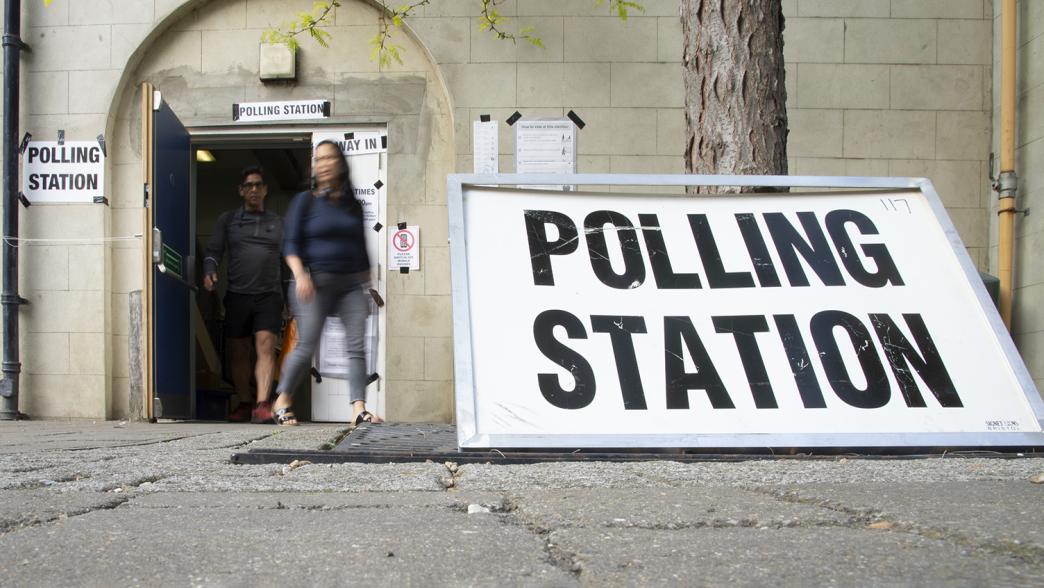
On 6 May 2021, also known as ‘Super Thursday’, elections took place across England, Scotland and Wales as an unprecedentedly large number of devolved, mayoral and local elections took place on the same day.
In Scotland, parties in favour of secession from the UK won a record 72 out of 129 seats, and almost exactly half the vote. Nicola Sturgeon is now pushing hard for Westminster to allow a second referendum.
In Wales, Labour secured a sixth consecutive term in office in Cardiff, winning precisely half the 60 seats in the Welsh parliament. This result was a setback for Plaid Cymru, which had hoped to put the issue of Welsh independence seriously on the agenda.
In both Scotland and Wales, the long-serving incumbent parties of government in Scotland and Wales were comfortably re-elected, despite coming under some pressure over their domestic public service performance records.
In England, the Conservatives won the Hartlepool by-election and made local election gains in other parts of the red wall – in the North East, the midlands, Essex and elsewhere. The Conservative metro mayors in the West Midlands and Tees Valley were comfortably re-elected too. And the party made 10 gains among the 39 police and crime commissioner elections contested in England and Wales.
Labour also had some reasons for celebration in England, with victories for its mayoral candidates in London, and the Manchester, Liverpool, Leeds, Bristol and Cambridge city-regions. But most of these victories appeared to have more to do with local issues and popular incumbents than they were an endorsement of the national Labour leadership.
In anticipation of polling day, the Institute for Government analysed past results, polling trends and the key issues at stake. We also identified 10 key questions about the elections. With the results in, we can now answer some, but not all, of these questions.

The SNP were returned once again as by far the largest party in the Scottish parliament.
1. Was there a pro-independence majority (again) in the Scottish parliament?
The SNP were returned once again as by far the largest party in the Scottish parliament, winning won 64 seats – leaving them one short of an outright majority.
Some unionist politicians and commentators have argued that falling short of a majority undermines first minister Nicola Sturgeon’s claim that she has a mandate to hold a second independence referendum. However, when combined with the eight Scottish Green members elected, there is a clear majority in favour of independence in the 129-seat Scottish parliament.
This means that the Scottish government has the numbers in Holyrood to pass its planned independence referendum bill. It is less clear that any such bill would be allowed to stand. Unless the UK government gives its backing to the referendum plan, the SNP legislation would face the prospect of being blocked in the UK Supreme Court, on the grounds that it falls outside the scope of the Scottish parliament’s powers.
Nonetheless, the election result ensures that the independence question will remain at the centre of Scottish – if not UK – politics for the foreseeable future as there is no obvious reason to differentiate between a single-party SNP majority and a SNP-Green combined majority, when both parties were elected on clear manifesto commitments to hold a referendum.
Indeed, the Scottish parliament is elected using a proportional system that makes it hard, but not impossible, for any single party to secure a majority. As our chart shows, the 2021 election is the third successive election at which a majority of MSPs back secession from the UK. In 2011, the SNP won an outright majority of 69 seats, based on a vote share of 45%. The SNP lost its majority in 2016 but, combined with the pro-independence Scottish Greens, a narrow majority in favour of independence was returned once more. In 2021, the SNP and Scottish Greens gained 72 seats between them, to return the largest ever pro-independence majority.
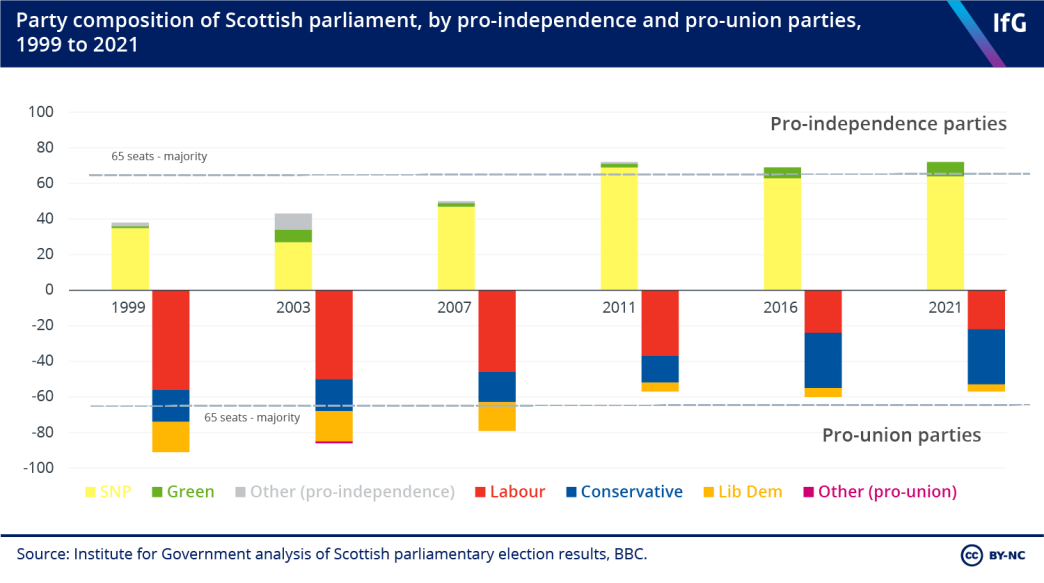
In terms of vote share, as our second chart shows, almost exactly 50% of Scottish voters backed pro-independence parties in the regional list vote.
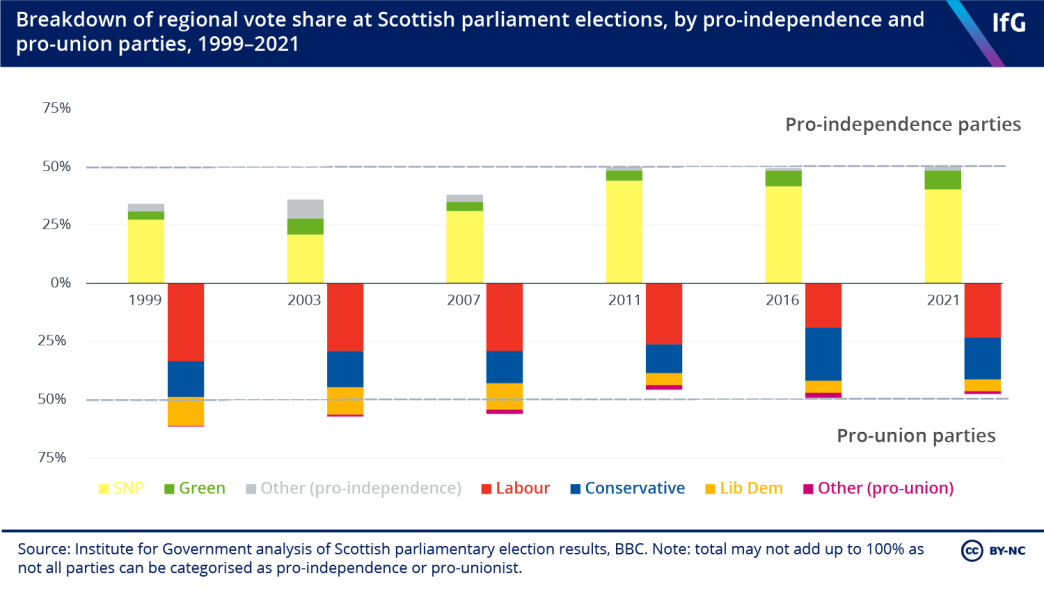
2. Has support for Scottish independence peaked?
While Scottish independence was the dominant issue in the 2021 election campaign, other factors also determined whether or not people voted for the SNP. For instance, many Scottish voters hold a more favourable view of how Nicola Sturgeon has handled coronavirus than they do of Boris Johnson.
So even though the election returned a pro-independence majority, and even if the SNP finds a way to hold a legal referendum, the party will be cautious about rushing into a second vote on independence without being sure of victory.
At the 2014 referendum, 55% of Scots voted to remain in the UK. Since then, as our chart shows, support for independence rose after the referendum, but then fell back to around the 45% mark. Support for independence rose slowly in 2018 and 2019, then picked up speed after the 2019 general election.
Through most of 2020 and early 2021, support for independence stood consistently at over 50%. However, as the election approached, this has fallen back once more, perhaps as the prospect of another referendum began to feel more real. In the 10 polls conducted in the two weeks before the election, Yes was ahead in only one.
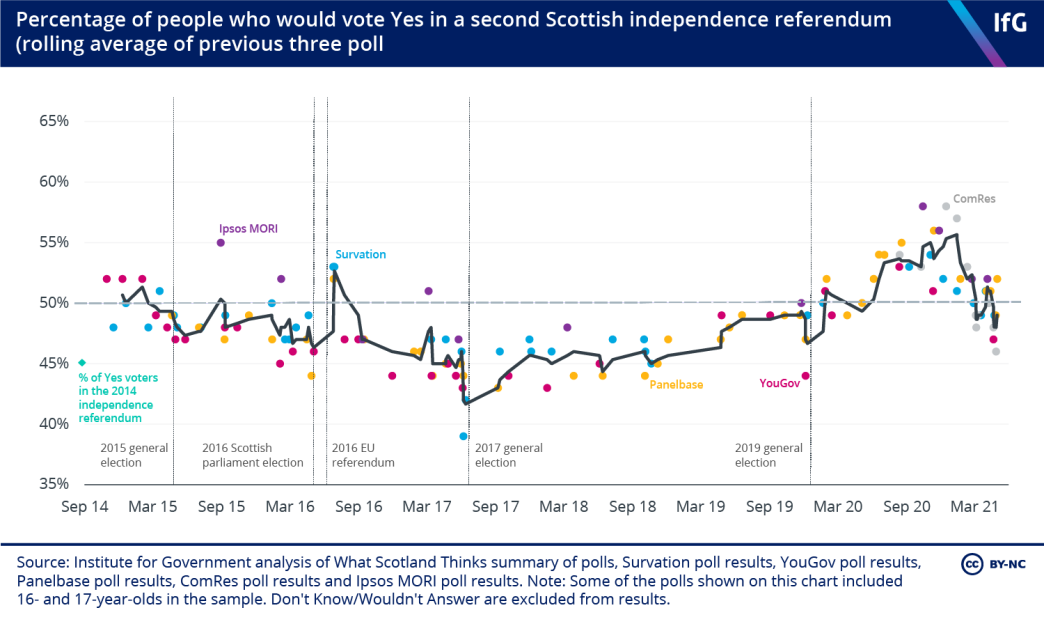

Labour has now been in government ever since 1999, winning between 26 and 30 seats at each of the six devolved elections held to date.
3. Did Labour's long dominance of Welsh politics hold?
The Welsh election also delivered a convincing victory for the incumbent government, led in this case by Welsh Labour, which won exactly half the seats in the 60-member Senedd (Welsh parliament). Labour has now been in government ever since 1999, winning between 26 and 30 seats at each of the six devolved elections held to date.
In 2016, Labour won 29 seats, but this result disguised a substantial decline in vote share (of 8% and 5% in terms of constituency and regional votes respectively) which, due to the Welsh electoral system, only translated into the loss of one seat. In 2021, the party regained most of those lost votes and the one seat it had lost.
The Conservative Party did not manage to replicate its strong 2019 general election showing in Wales, but it enjoyed its most successful ever Welsh election and became the second largest party in the Senedd for the first time.
Labour had also appeared to face a strong challenge from its other flank, with Plaid Cymru pushing for an expansion of borrowing and public spending, as well as a referendum on Welsh independence. However, Plaid had a disappointing result and failed to make a breakthrough, gaining just one seat but on the basis of an almost identical vote share to 2016.
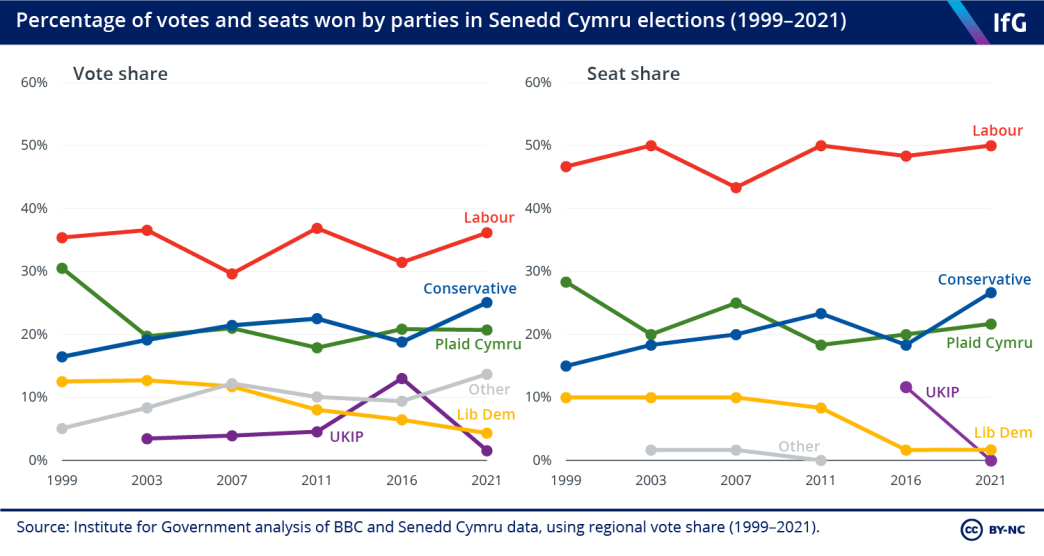
4. Is Welsh independence now a serious proposition?
The failure of Plaid Cymru to make a serious breakthrough in the 2021 election appears to have knocked the independence question off the agenda for at least the next five years. Welsh independence has never enjoyed the same level of political or public support as its Scottish counterpart, and Plaid Cymru has never emulated the electoral success of the SNP: the Welsh nationalists have never topped the poll in any nationwide election.
Under Adam Price, who became leader in 2018, Plaid has taken a firm pro-independence line. The Plaid Cymru manifesto committed to passing a Welsh Self-Determination Act, which would create a national commission to oversee the process leading up to a referendum within five years. As in the case of Scotland, it is probable that any attempt to hold a referendum would be blocked by Westminster or the UK Supreme Court.
Polls suggest a gradual rise in support for independence, rising from 20% in 2014 to between 30% and 35%, with ‘don’t knows’ excluded, in polls conducted in since 2019. Scottish independence enjoyed a similar level of support as recently as 2012. But the 2021 election result demonstrates that Welsh nationalism remains a far weaker force than its Scottish counterpart.
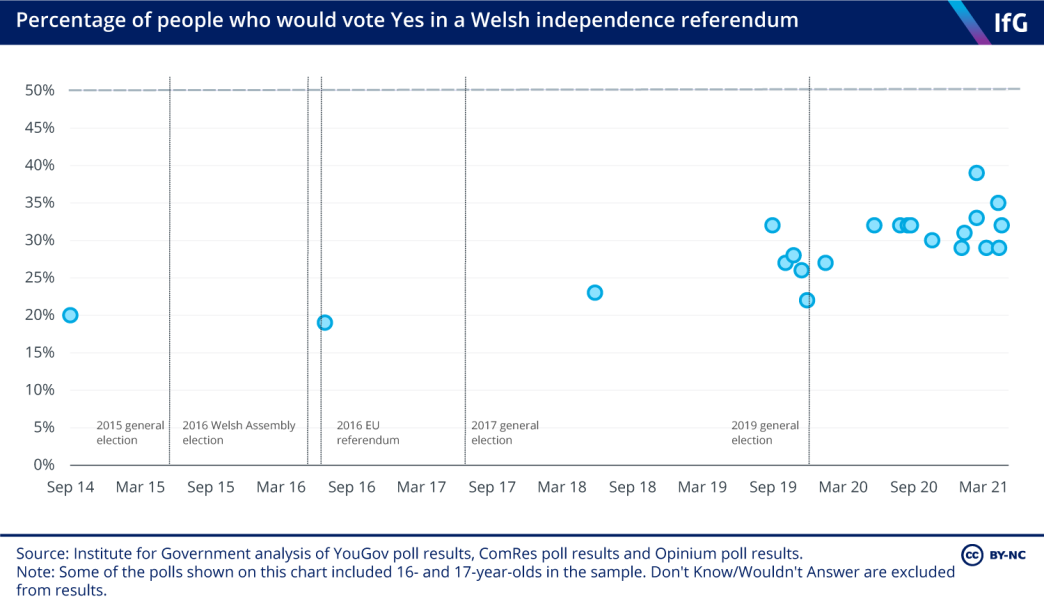

Recent Institute for Government analysis found that public spending in Scotland on devolved functions stood at 29% above the level of spending on comparative services in England.
5. Did the SNP and Plaid set out how an independent Scotland or Wales would address their large deficits?
There has been no serious debate about how Scottish or Welsh independence would work in reality, or how, as independent states, Scotland and Wales would be able to sustain the level of public spending to which their citizens are accustomed. The issue in Wales is now moot, but in Scotland the SNP is likely to come under increasing pressure to clarify what the impact of independence would be on levels of public spending and taxation.
Recent Institute for Government analysis found that public spending in Scotland on devolved functions stood at 29% above the level of spending on comparative services in England. Scotland also generates less tax revenue than England. Combining these two factors means that Scotland has a notional deficit of £2,700 per person, far in excess of the small deficit of £100 per capita in England.
In effect, there is currently a sizeable fiscal transfer to Scotland from England (in particular from London and the South East), via the Barnett formula, which funds the devolved government’s own spending, and also through welfare spending, which is higher in Scotland than in England.
The SNP argues that as independent states Scotland and Wales would have the necessary fiscal and economic powers to improve productivity, and to spend public spending in ways that is more suited to local needs. Whether or not that is true in the long run, the immediate challenge for an independent Scotland would be to fill the hole left by the withdrawal of fiscal support from Westminster.
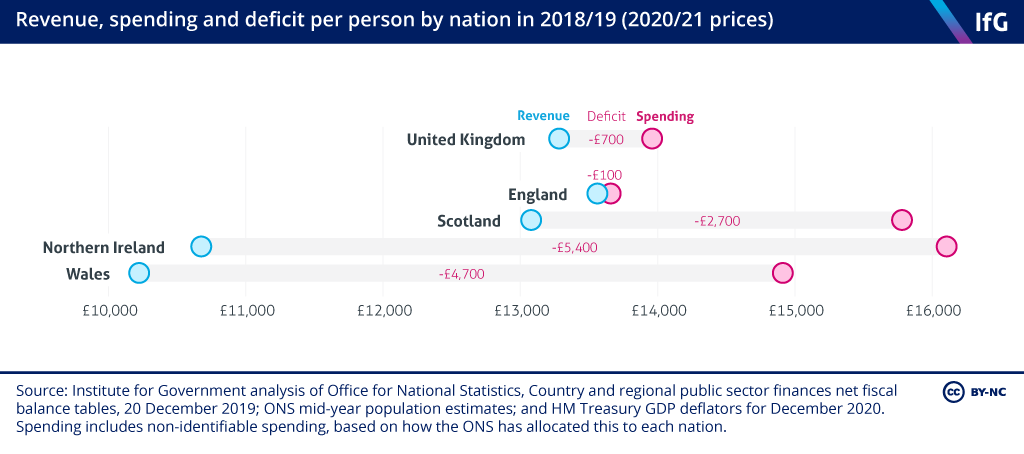

Labour’s Tracy Brabin became the newly elected West Yorkshire mayor.
6. Will the 2021 elections bring about a shift in the balance of power at the local and devolved level within England?
Of the seven metro mayor elections held on 6 May, Labour won five and the Conservatives two. Labour’s Tracy Brabin became the newly elected West Yorkshire mayor, while Labour gained two mayoralties won by the Conservatives in 2017, in the West of England and Cambridgeshire and Peterborough.
In most of the other metro mayor elections, incumbents performed well. This was particularly striking in the two Conservative-held mayoralties: West Midlands mayor Andy Street increased his first-round vote share by seven percentage-points, and in Tees Valley Ben Houchen won 72.8% on the first-round, a huge increase on the 2017 election, when he won by a very narrow margin. In Greater Manchester, Andy Burnham was also comfortably re-elected on 67.3% of the first-round vote. In London and the Liverpool City Region, the incumbent Labour mayors were also relatively comfortably re-elected, albeit with a swing to the Conservatives in both cases.
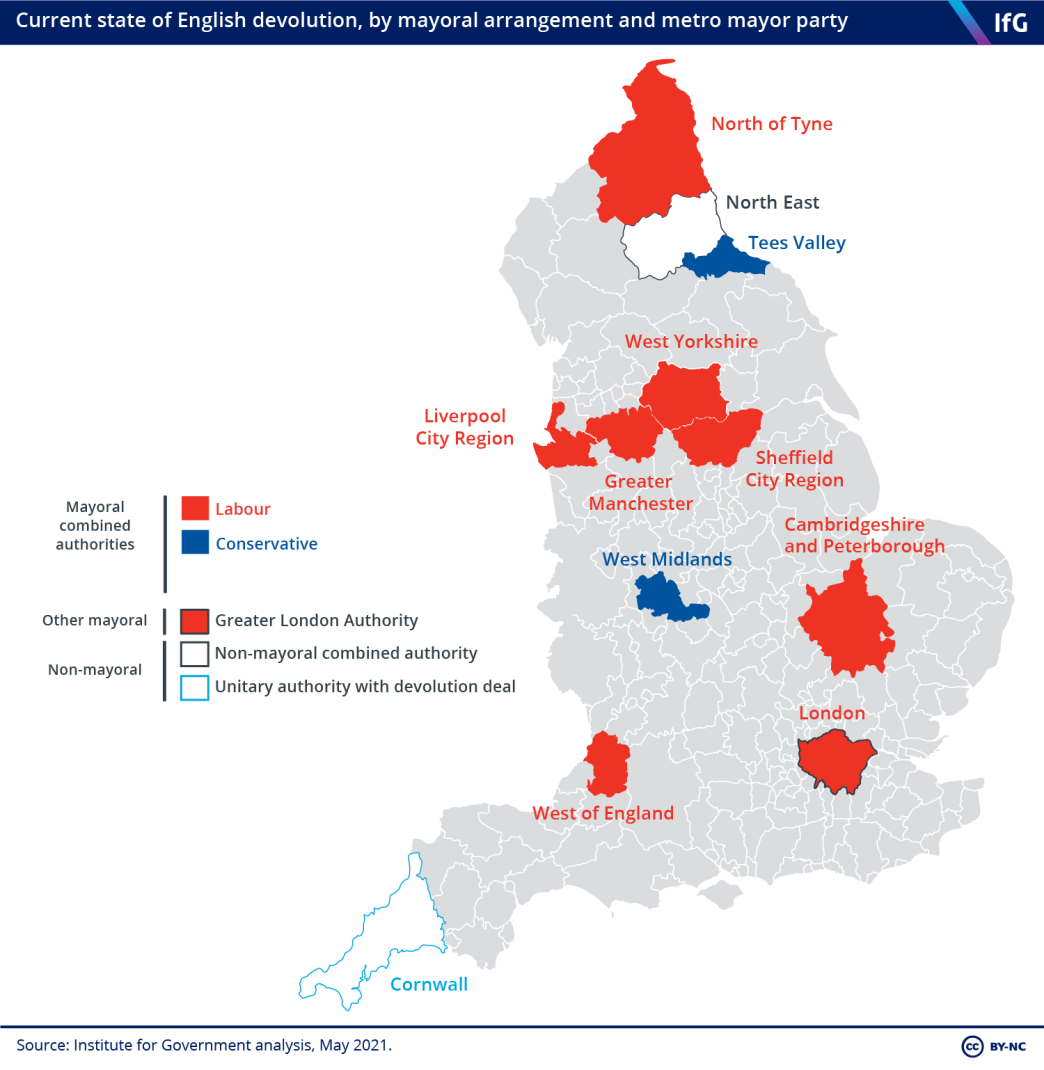
Labour also held all five of the single authority executive mayoral posts up for election, in Bristol, Doncaster, Liverpool, North Tyneside and Salford.
At the council level the Conservatives performed more strongly, winning control of 13 councils and gaining 235 council seats.[1] As expected, the party made significant gains in Brexit-leaning areas last contested in 2016, such as Dudley, Rotherham and Amber Valley. In contrast, Labour lost control of eight councils and lost 327 council seats. The Conservatives also successfully held many of the county councils they took control of in 2017, including Derbyshire and Lancashire. Outside the two main parties, the Greens were the standout performers, making 88 seat gains across a range of councils, including Sheffield, South Tyneside and Suffolk.
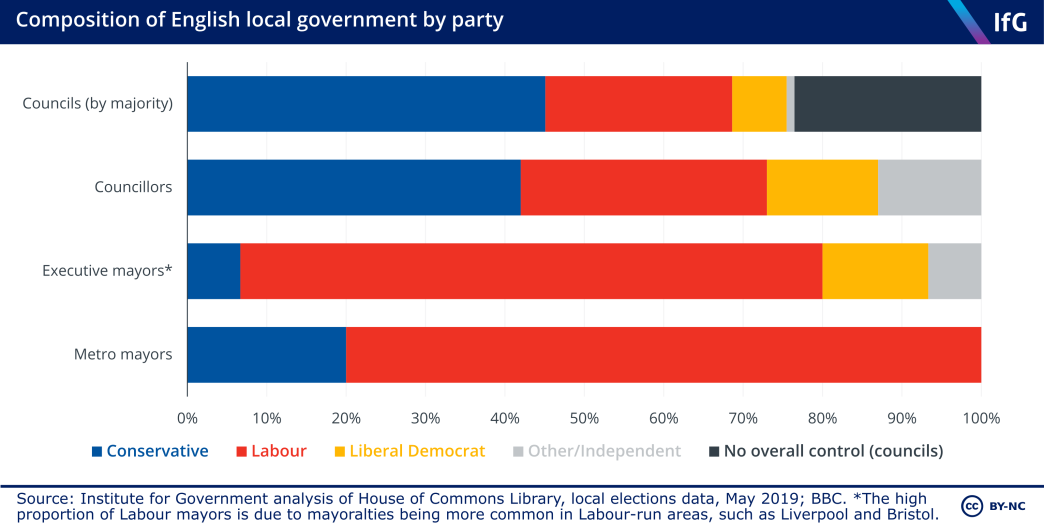
- BBC News, England local elections 2021, www.bbc.co.uk/news/topics/c481drqqzv7t/england-local-elections-2021
7. Does the government have a plan to extend devolution to the rest of England?
The devolution process within England was accelerated after 2015, as then chancellor George Osborne called for a “devolution revolution”.[1] The government struck deals with local leaders in a number of urban areas across England to create new devolved institutions, known as mayoral combined authorities (MCAs), and to transfer some powers and budgets.
Devolution in England remains an ongoing process. At the first set of mayoral elections in 2017, six mayors were elected to their posts. Since then, three more mayoral combined authorities – in Sheffield, North of Tyne and West Yorkshire – have been established.
But even after the election of the new West Yorkshire mayor, only 41% of the English population live in areas with mayoral devolution arrangements.
Despite the government committing to “full devolution across England” in its 2019 manifesto, it has apparently dropped plans for an English devolution white paper, which will be replaced by a white paper on levelling up. It remains to be seen whether the levelling up agenda will include commitments to further devolution or whether it will primarily consist of a Whitehall-driven investment and growth agenda.
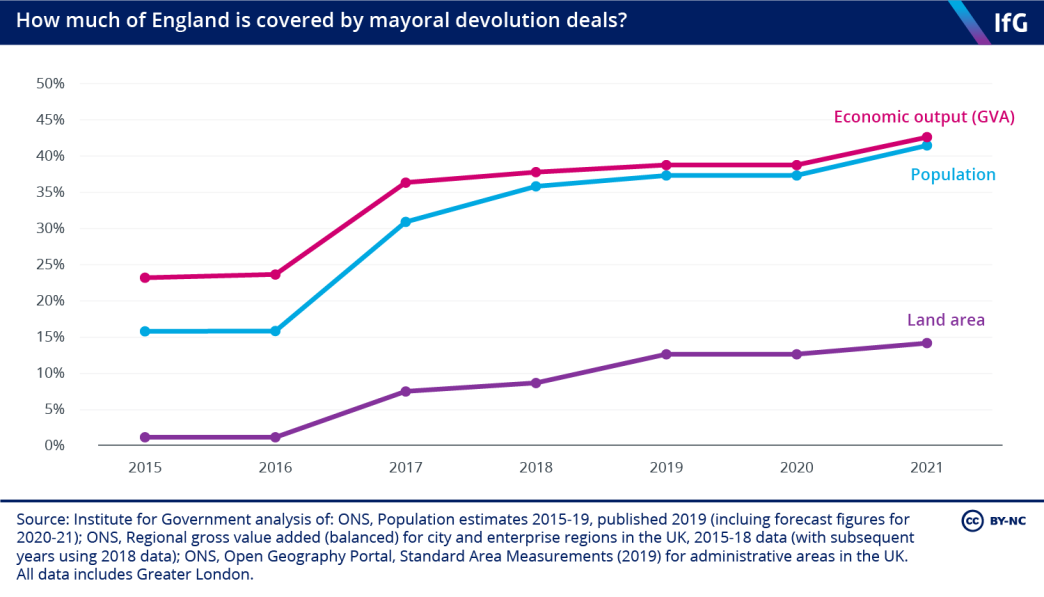
- HM Treasury and The Rt Hon George Osborne, 'Chancellor unveils 'devolution revolution'', 5 October 2015, www.gov.uk/government/news/chancellor-unveils-devolution-revolution

The government has repeatedly committed itself to ‘levelling-up’ the poorer areas of England.
8. Will devolution within England help to close the gap in economic performance between richer and poorer areas?
The government has repeatedly committed itself to ‘levelling-up’ the poorer areas of England, which lag behind London and the South East on various measures of economic performance, including gross value added, as shown in the chart. Latest government statistics show that public spending in these regions is lower than in Scotland, Wales and Northern Ireland, and, in the cases of the midlands and West Yorkshire, below the UK average.
But devolution to cities within these wider regions has only transferred a relatively small level of financial resources from Westminster to the devolved level, and has not yet significantly improved their economies. Following the perceived electoral endorsement of ‘levelling-up’ at the 6 May elections, the government has underlined in the Queen’s Speech its plan to ‘level up opportunities across all parties of the United Kingdom’ as one of their central priorities.[1] It will now have to decide how to best continue the devolution agenda and how it works with the newly elected and re-elected mayors in order to improve the economic fortunes of these cities and their wider regions.
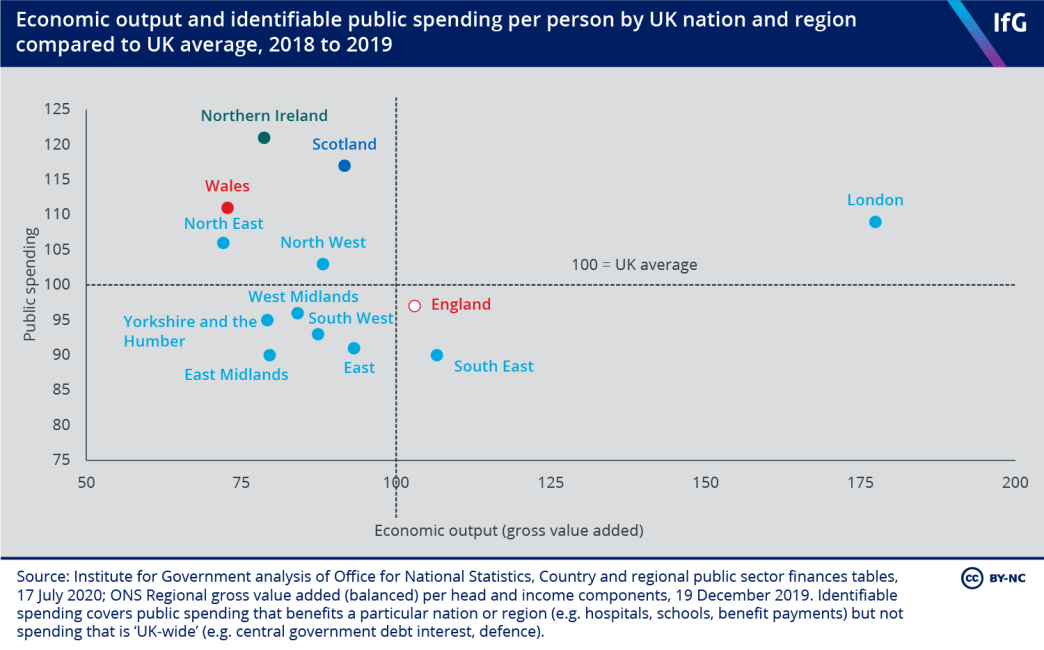
- Prime Minister's Office, 10 Downing Street, Queen's Speech 2021: background briefing notes, 11 May 2021, www.gov.uk/government/publications/queens-speech-2021-background-briefing-notes

The Conservatives won the seat of Hartlepool with a strong majority of 6,940 and overall vote share of 51.9%.
9. Did the Conservatives make a rare by-election gain as a governing party?
The Conservatives won the seat of Hartlepool with a strong majority of 6,940 and overall vote share of 51.9%, taking a significant proportion of the Brexit Party’s 25.8% of the vote in 2019.
The Conservatives’ increased share of the vote by 23 percentage-points compared to the 2019 general election represents the largest increase in the vote share of a governing party at a by-election in the post-war era. As the chart below shows, this bucks the historic trend of by-election results. Up until this result, in every parliament since the second world war, on average, the vote share of the incumbent prime ministers’ party had gone down.
Three upcoming by-elections, in Batley and Spen, Chesham and Amersham, and Airdrie and Shotts – will help determine whether Hartlepool was an exception to this historical trend, or whether this incumbent government will continue to perform well at by-elections.
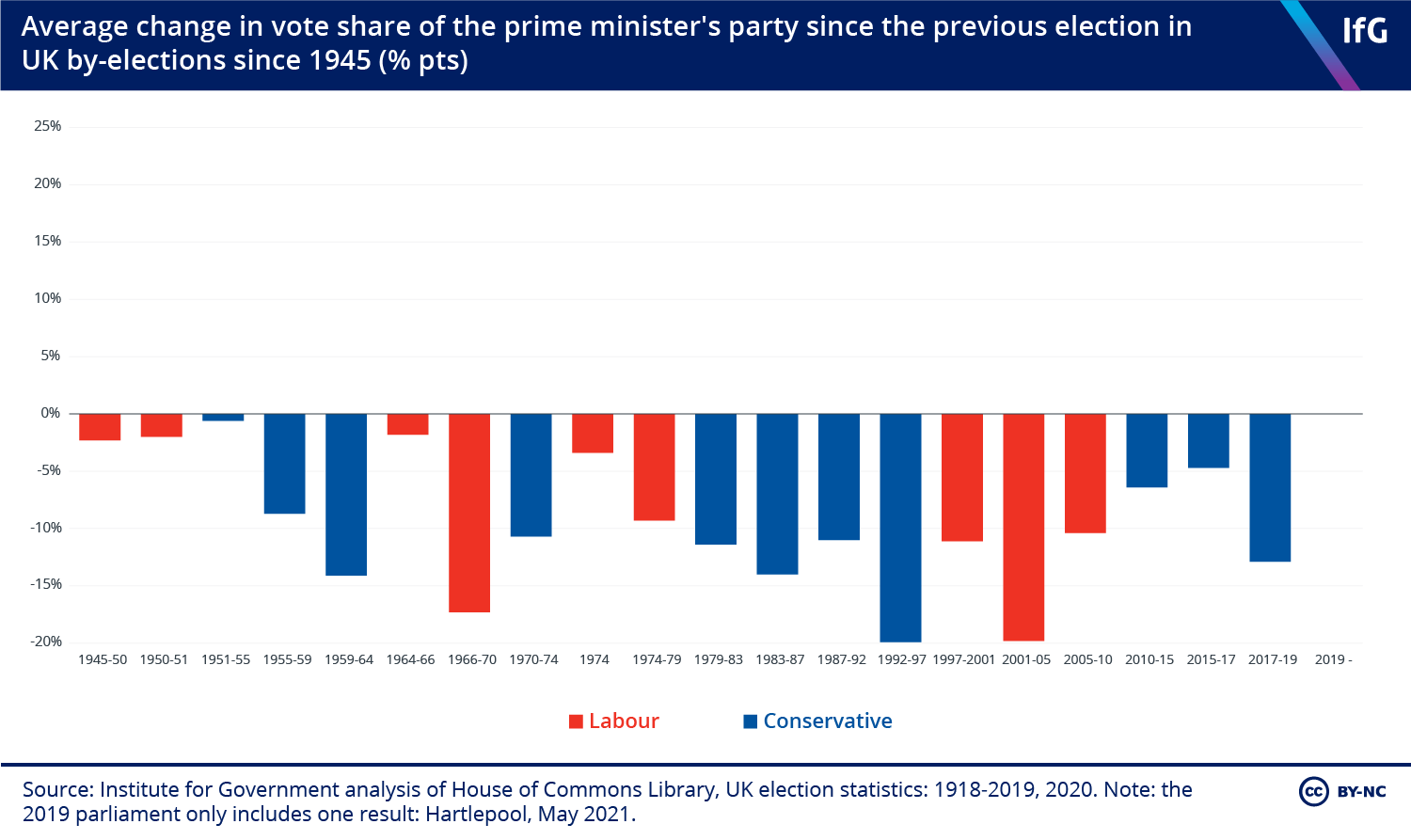

Covid does not appear to have had a negative impact on turnout – in most elections, turnout actually increased.
10. Did turnout suffer due to Covid?
Turnout at local and devolved elections already tends to be lower than for UK general elections. Additionally, on election day the coronavirus pandemic and certain restrictions were still ongoing, which had led to concern that turnout might fall.
However, as the chart shows, Covid does not appear to have had a negative impact on turnout – in most elections, turnout actually increased. This was most evident in Scotland, where turnout rose by almost eight percentage-points to 63.4% – levels we might expect to see at a UK general election. There was also an – albeit smaller – increase in Wales, from 45.5% in 2016 to 46.6% in 2021.
In London, turnout for the mayoral and Assembly elections dropped slightly, from 46% in 2016 to 42.2% this year. However, there are reasons other than Covid that can explain a reduction in turnout in London, in particular the record 5% of first preference votes that were ruled out as invalid due to confusion over the ballot paper.[1]
The other city regions which held metro mayor elections in 2021 all recorded increased turnout on the first round of elections in 2017. The average turnout across the seven metro mayor elections in 2021 (including West Yorkshire, which held its first mayoral election this year) was 34.2%, up almost seven percentage-points on the 2017 average.
Turnout for police and crime commissioner elections was also higher than in 2016, and significantly greater than the 2012 election.
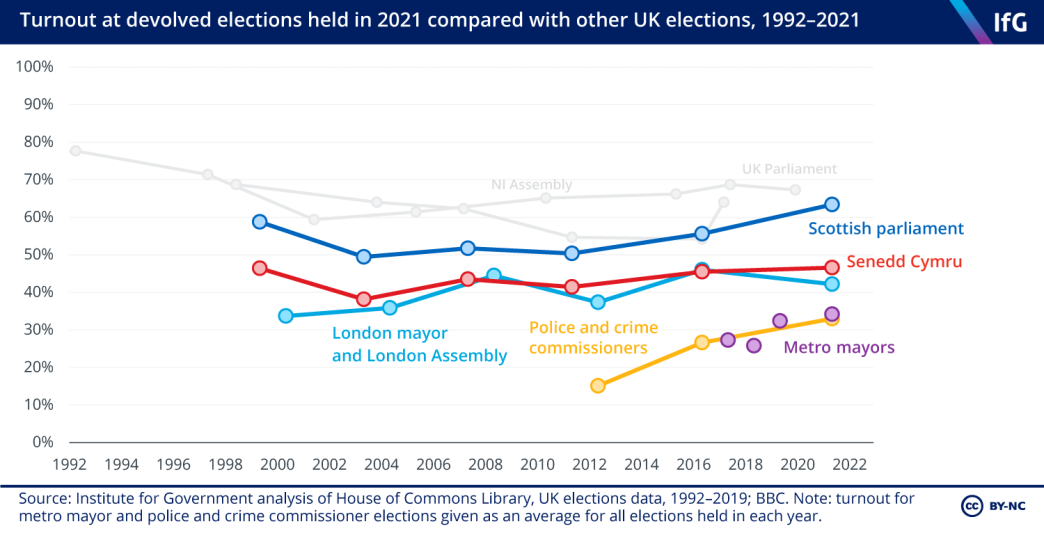
- BBC News, London elections 2021: Record number of mayoral votes rejected, 10 May, www.bbc.co.uk/news/uk-england-london-57049779
- Topic
- Devolution
- Devolved administration
- Scottish government Welsh government
- Legislature
- Scottish parliament Senedd
- Public figures
- Nicola Sturgeon
- Publisher
- Institute for Government